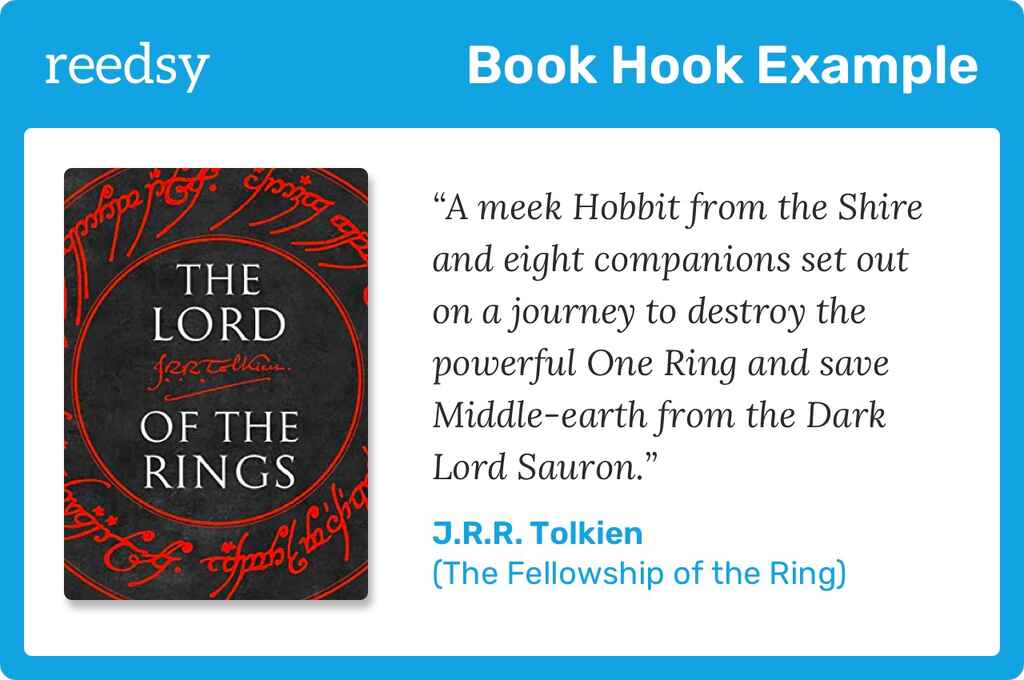Guides • Perfecting your Craft
Last updated on Nov 09, 2023
How To Craft a Book Hook (Tips from Editors)
About the author
Reedsy's editorial team is a diverse group of industry experts devoted to helping authors write and publish beautiful books.
More about the Reedsy Editorial Team →Dario Villirilli
Editor-in-Chief of the Reedsy blog, Dario is a graduate of Mälardalen University. As a freelance writer, he has written for many esteemed outlets aimed at writers. A traveler at heart, he can be found roaming the world and working from his laptop.
View profile →Could you describe what your book is about in a clear, engaging, and concise manner? That's precisely the purpose of a book hook, also known as a pitch.
In this post, we'll break down what a book hook is, why it matters for authors, and how to craft a successful one, borrowing from the wisdom of accomplished authors, editors, and literary agents.
What is a book hook?
A book hook or pitch is a one-sentence summary that encapsulates the essence of your book and leaves the listener or reader intrigued. Whether you share it with a literary agent, a potential reader, or a total stranger, the goal is to leave them eager to hear more.
It is based on the concept of the "elevator pitch," which comes from the business world and refers to the scenario of being able to clearly and succinctly present a business idea to people who could help make it a reality by the time they reach their floor.
🪝The terms "hook" and "elevator pitch" refer to the same concept but are used in different settings. The hook is the written version, ideal for marketing materials and book descriptions. The elevator pitch is the spoken version you'd use in a face-to-face conversation, perhaps with an agent or publisher.
In the literary world, a pitch has multiple purposes depending on where you are in the publishing process. It can serve as a "North Star" as you write your book, but also as a sales tool to pitch it to agents or readers once the book is ready to hit the market.
🖋️
Are you ready for a literary agent?
Find out here! Takes one minute.
Your North Star as you write the book
Author Tom Bromley, the instructor behind Reedsy's How to Write a Novel course, argues that it’s a good idea to craft your pitch before you even start writing. “The process of pruning down your story to a single sentence is invaluable. It’ll really help you understand what is at your novel’s heart. The sharper and clearer you can make that pitch, the smoother a writing journey you'll have.”
A well-crafted book pitch can serve as a lifeline when you're grappling with writer's block or feel like you're losing the thread of your plot. “I always advise my students to keep their pitch on a post-it note for easy reference. Then ask themselves, 'How does this chapter contribute to my core idea?' If it doesn't, they might be veering off course.”
The pitch will also come handy in the book publication phase.
Your very first sales tool
A book pitch is an essential part of promoting your book. You can use it as a compelling first line in your Amazon blurb, as a hook that nicely leads to the book synopsis of your query letter, or simply place it on the back of the book cover or social media banners to intrigue potential readers.
As editor Rebecca Heyman points out, the process of crafting your book pitch can help you become more comfortable with selling your book. “Advocating for your book and your story is a critical part of going from the inward-facing process of authorship, to the outer-facing process of obtaining readership.”
Let's look into how to write a book pitch, and what its essential components are.
How to write a book hook
A well-crafted book hook often introduces some story elements, like the main character, central conflict, and stakes, and potentially other intriguing details, like a unique setting or magic system. There isn’t a single formula to write a pitch, but there are a few essential elements to keep in mind.
Include conflict, change, and details
According to Tom Bromley, the pitch should emphasize the central conflict that drives your story. “Conflict creates dramatic tension, especially when its outcome is uncertain.” Additionally, since stories revolve around change, it should hint at some character’s transformation. Finally, it could include some details, like character names or the setting, to distinguish it from other stories.
Let’s take as an example the hook for The Fellowship of the Ring by J. R. R. Tolkien:

The central conflict driving the story is the goal of destroying the ring to save Middle-earth from evil. The change the protagonist will go through is hinted at by describing him as a “meek Hobbit.” Finally, details such as “the Shire,” “the One Ring,” and “Dark Lord Sauron” hint at the worldbuilding that makes the story stand out from other novels with similar elements and tropes.
Introduce the character, conflict, and stakes
For another perspective, editor Rebecca Heyman argues that the pitch should introduce the main characters, the primary conflict, and the stakes. “The stakes are the reason people care about the conflict — the larger personal or global impact that the resolution of the conflict will have on the main character.”
Similar to Tom’s advice, there are subtle differences. Let’s take the hook for The Martian by Andy Weir as an example:

You have a main character (the astronaut,) his goal/conflict (surviving Mars until rescue,) and the stakes (testing the limits of human ingenuity and, obviously, his life.) What will he come up with? Will his team help him? Will he survive?
As editor and former literary agent Jennifer Udden says, a great pitch leaves the listener intrigued, not confused. "Your audience should have questions because they're excited, not because they require answers to those questions to get excited."
🤓 Watch editors Rebecca Heyman and Jennifer Udden review several book pitches submitted by aspiring authors, giving tips on how to improve them.
To craft your hook, it might be useful to break down your story into these components:
- The main characters
- Their primary conflict/goal
- What’s at stake if they don’t achieve it
But also identify some surprising story elements or details that could help make it stand out. As a starting point, you could use this template:
Set in [place and time period], the story follows [protagonist], who wants to [goal/motivation], but [conflict] doesn’t make that easy, putting [stake] at risk.
Ultimately, your hook should be as unique as your book, so tinker with it until it “feels right.” As you read it out loud or test it on friends, it should sound smooth, clear, and captivating. To get a better sense of what a good hook sounds like, read our next post, which lists dozens of book pitch examples.
Q: What are the key elements authors should include in their hook to make their query more compelling?
Suggested answer
Hooks should always include:
- Stakes. What is on the line here? In quieter or more character-driven stories, this is still important. The stakes might not be life and death, but they need to feel emotionally powerful.
- Main character: a sense of who this story is about
- The hero’s / heroine’s journey: Our protagonist is on a mission. What is it?
- The story world: What is the context for this journey? In SFF, the author has to be careful not to get too into the weeds here; it’s about broad strokes.
- Antagonist or antagonistic forces: What obstructs the protagonist from easily completing their mission?
- Voice: Any time we write a logline, query, build a hook, or write a synopsis, we have to make sure our unique authorial voice shines through.
Happy writing!
Wendy is available to hire on Reedsy ⏺


